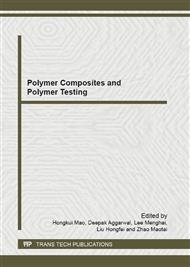p.3
p.7
p.12
p.16
p.20
p.25
p.31
p.35
p.40
Finite Element Implementations to Predict the Failure of Composite Laminates Under Uniaxial Tension
Abstract:
This paper aims to simulate the failure behaviour of composite laminates subjected to uniaxial loading using commercial software (ANSYS) and FE programme (Fortran). For the first time, the built-in failure criteria functions provided by ANSYS were explored extensively and successfully exploited to predict the failure curves of composite laminates. Finite element (FE) models are developed to replicate physical testing. A FE programme is developed using Fortan-90 to determine the lamina stresses based on High Order Shear Deformation Theory (HSDT). These stresses are then used to determine the strength of the plates using the Maximum Stress Failure Criteria. Then FE models are developed using ANSYS to replicate the procedure. Standard ANSYS formulation is utilised and laminate failure was predicted based on Maximum Stress and Tsai-Wu Failure Criteria. The failure curves for both approaches were plotted and found very close to the experiment results. The results show that the FE programme and ANSYS simulations produce an average error of 8% and 15% respectively. Nevertheless, simulations using ANSYS allows easier modification and manipulation. Therefore, it can be concluded the current study is useful and significant and contributes significant knowledge to the failure behaviour of composite laminate. Moreover, the simulations performed could eventually replace tedious and expensive physical testing.
Info:
Periodical:
Pages:
20-24
Citation:
Online since:
April 2012
Price:
Сopyright:
© 2012 Trans Tech Publications Ltd. All Rights Reserved
Share:
Citation:


